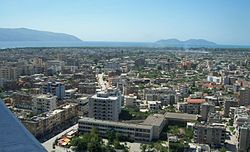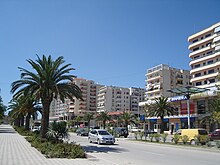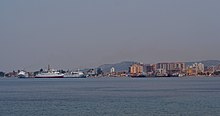Vlorë
Vlorë
Aulona, Valona | |
|---|---|
 View over Vlorë | |
| Nickname: Qyteti i Pavarësisë (The city of Independence) | |
| Motto(s): Përherë kuqezi (Always red and black) | |
| Country | Albania |
| County | Vlorë County |
| District | Vlorë District |
| Founded | 6th century BC |
| Government | |
| • Mayor | Shpëtim Gjika (PS) |
| Elevation | 0 m (0 ft) |
| Population (2006) | |
| • Total | 185,000 |
| Time zone | UTC+1 (Central European Time) |
| • Summer (DST) | UTC+2 (CEST) |
| Postal code | 9400 |
| Area code | 33 |
| Car Plates | VL |
| Website | http://www.bashkiavlore.org |
Vlorë or Vlora is the second largest port city of Albania, after Durrës, with a population of about 124,000 (2006 estimate).
Names
The modern name for the city is the Albanian form Vlorë or Vlora, IPA: [vɭoˈɾə]. Vlorë was created in antiquity as a Greek colony in the territory of Illyria. Its first name, still used today in Greece, is Aulón (Greek: Αυλών), which means valley, but may have been a reinterpretation of a pre-Greek name.[1]. In early 20th century, Vlorë was referred to in English as Avlona or by the Italian name Valona.[2].
Location

The city is located in Albania, in the District of Vlorë and County of Vlorë.
Vlorë occupies an eminence near the Bay of Vlorë, an inlet of the facing the Adriatic Sea, almost surrounded by mountains. The port of Vlorë is the closest in proximity to the port of Bari, Italy and is just 70 nautical miles from Salento's coasts. The island of Sazan is in close proximity to the city, strategically located at the entrance to the Bay of Vlorë. The town has rather a pleasant appearance, surrounded with gardens and olive groves. Valonia, a material largely used by tanners, is the pericarp of an acorn obtained in the neighboring oak forests, and derives its name from Valona, the ancient name of Vlorë.
History
Vlorë is one of the oldest cities of Albania. It was founded by Greeks in the 6th century BC and named Aulōn, one of three such colonies on the Illyrian coast[3], mentioned for the first time by Ptolemy (Geographia, III, xii, 2). Other geographical documents, such as Peutinger's "Tabula" and the "Synecdemus" of Hierocles, also mention it. The city was an important port of the Roman Empire, when it was part of Epirus Nova.
It became an episcopal see in the 5th century. Among the known bishops are Nazarius, in 458, and Soter, in 553 (Daniele Farlati, Illyricum sacrum, VII, 397-401). The diocese at that time belonged to the Patriarchate of Rome. In 733 it was annexed, with all eastern Illyricum, to the Ecumenical Patriarchate of Constantinople, and yet it is not mentioned in any Notitiae episcopatuum of that Church. The bishopric had probably been suppressed, for, though the Bulgarians had been in possession of this country for some time, Avlona is not mentioned in the "Notitiae episcopatuum" of the Patriarchate of Achrida. Vlorë played a central role in the conflicts between the Norman Kingdom of Sicily and the Byzantine Empire during the 11th and 12th centuries. During the Latin domination a Latin see was established, and Eubel (Hierarchia catholica medii aevi, I, 124) mentions several of its bishops. Several of the Latin bishops mentioned by Le Quien (Oriens christianus, III, 855-8), and whom Eubel (I, 541) mentions under the See of Valanea in Syria, belong either to Aulon in Greece (now Salona) or to Aulon in Albania (Vlorë).

Serbia captured Vlorë, or Valona, as it was also called, in 1345 and it was captured by the Ottoman Empire in 1417; and after being in Venetian possession in 1690, was restored to the Turks in 1691, becoming a caza of the sandjak of Berat in the vilayet (province) of Janina. The city had about 10,000 inhabitants; there was a Catholic parish, which belonged to the Archdiocese of Durrës; it persisted nominally as a Titular see, suffragan of Durrës.
In 1851 it suffered severely from an earthquake.
Ismail Qemali declared Albania's independence in Vlorë on November 28, 1912, during the First Balkan War. The city became Albania's first capital but was invaded by Italy in 1914 and occupied until 1920. Italy again invaded Vlorë in 1939, following which Nazi Germany occupied the city until 1944.
During World War II, the island of Sazan in Bay of Vlorë became the site of a German and Italian submarine base and naval installations; these were heavily bombed by the Allies.

After WWII, under communism, the port was leased to the Soviet Union as a submarine base, and played an important part in the conflict between Enver Hoxha and Khrushchev in 1960-1961, as the Soviet Union had made considerable investments in the naval facilities and objected strongly to the loss of them as a consequence of Albania denouncing the USSR as 'revisionist' and taking the Chinese side in the split in the world communist movement. The Soviet Union threatened to occupy Vlora with Soviet troops in April 1961, and cut off all Soviet economic, military and technical aid to Albania. The threat was not carried out, as a result of the simultaneous development of the Cuban missiles crisis, but Hoxha realized how vulnerable Albania was, and, after the USSR invaded Czechoslovakia in 1968, he built the tens of thousands of ubiquitous concrete bunkers that still litter the entire Albanian landscape. Under Hoxha Vlorë was an important recruiting centre for the Sigurimi, the secret police.
In 1997, Vlorë was the center of popular riots after the collapse of several fraudulent investment schemes that led to the downfall of the Sali Berisha administration, and almost precipitated the country into a civil war.
Education
Vlora is home of the second largest university in Albania. The University of Vlora Ismail Qemali (UV) was created in 1994 as a Technological University. It started with a few hundred students and today is the second biggest university in Albania with nearly 15 000 students. It still keeps its focus on technology, but it has expanded in economics and finance, education, medicine, and law.
Research

UV is the leading research university in Albania. It is the most active university in Albania in organizing research conferences, inviting researchers from leading institutions, and sending its own researchers abroad. Some of the most active areas of research are mathematics, computer science, and engineering. It has also active groups in Albanian literature, economics and finance, folk music and dance, education, etc.
Vlora Conference Center is a leading group in organizing conferences in Albania and has organized conferences in a yearly bases at the University of Vlora. Its board is made of internationally known scientists.

There are two internationally known journals which call the University of Vlora home. They are the highest quality journals of any Albanian speaking university.
Albanian Journal of Mathematics
Albanian Journal of Mechanical Engineering
There is also a scientific journal published quarterly in Albanian
Buletini Shkencor i Universitetit te Vlores
Many summer schools and training sessions are organized at the University. Vlora is a popular tourist destination and this makes it very attractive for organizing international conferences.

In addition, University of Vlora has excellent programs in naval engineering and navigation. Studying the Bay of Vlora has been one of the main projects of the navigation department in the last few years. The Bay of Vlora is a very important place in World's history with many important facts as Ceasar's battles, medieval times, World War I, and World War II, etc. In the bay is one of the oldest military naval bases in the world which continues to be used to this day. The Naval Base of Pashaliman was the only Russian base in the Mediterranean in the 1950s, it was the hot spot of conflict between the Russians and the Albanians in 1961 when Albania pulled out of the Warsaw Treaty. The Department of Navigation is mapping all the ships sunk in the bay area, is doing research in the area of marine archeology in the ancient town of Orikum (Oricum).
Researchers from UV participate in congresses and conferences all over the world. UV has joint projects and exchange programs with some of the best universities in th world and very actively is trying to expand further such programs. UV has taken the lead in all Albanian institutions to increase active cooperation with western universities and to have research as its first priority.
Economy

Vlorë remains a major seaport and commercial centre, with a significant fishing and industrial sector. The surrounding region produces petroleum, natural gas, bitumen and salt. The city is also the location of important installations of the Albanian Navy.
Vlorë has grown in importance as an agricultural center with very large-scale planting of olive and fruit trees, and as a center of the food processing, oil and bitumen export industries.
The surrounding district is mainly agricultural and pastoral, producing oats, maize, cotton, olive oil, cattle, sheep, skins, hides and butter. These commodities are exported.
Tourism has become a major industry in recent years, with many hotels, recreational centers, and vast beaches. It is a pleasant place to relax, to have a coffee and admire the beautiful view over the Bay of Vlorë.
Sports
The citizens of Vlorë enjoy many kinds of sports. The most popular though is football. Vlorë has two professional teams: KS Flamurtari Vlorë and Vlora City FC. Flamurtari currently plays in the Albanian Superliga, while Vlora FC competes in the Albanian Second Division. Other sports played in Vlorë include basketball, volleyball, handball, athletics and swimming.
People



- Kristaq Mitro - film director
- Ibrahim Muçaj - film director
- Skënder Kamberi - painter
- Nestor Jonuzi - painter
- Josif Gjipali - tenor
- Agim Sulaj - painter
- Aurela Gaçe - singer
- Ibrahim Sulejman Vogli- boxer
- Perlat Musta- goalkeeper (Partizani, national team)
- Kadri Hazbiu- Minister of Defence (1974-1981)
- Hysni Kapo - Secretary of the Central Committee of PLA
- Sabaudin Xhaferi - painter, art director, cartoonist
Sister Cities
See also
Sources and References
 This article incorporates text from a publication now in the public domain: Herbermann, Charles, ed. (1913). Catholic Encyclopedia. New York: Robert Appleton Company.
This article incorporates text from a publication now in the public domain: Herbermann, Charles, ed. (1913). Catholic Encyclopedia. New York: Robert Appleton Company. {{cite encyclopedia}}: Missing or empty|title=(help)- This article incorporates text from a publication now in the public domain: Chisholm, Hugh, ed. (1911). Encyclopædia Britannica (11th ed.). Cambridge University Press.
{{cite encyclopedia}}: Missing or empty|title=(help) - "Vlorë." Encyclopædia Britannica, 2005
- "Vlorë." The Columbia Encyclopedia, 2004
- "Vlorë or Vlora, Ital. Valona, ancient Aulon." Crystal Reference Encyclopedia, 2001
- Tourism Information about Vlore, Albania (Written by American Robert Nagle in 2002).
Citations
- ^ ,google book reference: Placenames of the World: Origins and Meanings of the Names for 6,600 Countries, Cities, Territories, Natural Features, and Historic Sites By Adrian Room Published by McFarland, 2005 ISBN 0786422483, 9780786422487 433 pages
- ^ Encyclopaedia Britannica, 11th edition (1911), "Avlona" article.
- ^ Vlore from Encyclopaedia Britannica Quote: "town that is the second seaport of Albania. It lies at the head of Vlorës Bay, which is protected by the mountainous Karaburun (peninsula) and the island of Sazan (Italian Saseno, ancient Saso). Of ancient origin, it was founded as Aulon, one of three Greek colonies on the Illyrian coast. It was strategically important during Roman times and in the 11th–12th-century wars between Normans and Byzantines. Later it was contested by Venetians, Serbs, and Turks. On Nov. 28, 1912, Ismail Qemal proclaimed there the independence of Albania. Vlorë was occupied by the Italians in 1915–20 and again in 1939. During World War II Sazan was used as a German and Italian submarine base. After the war the town’s harbour and submarine facilities were improved by the Soviet Union, which used the bay as a naval base until 1961, when conflict between the two states resulted in a Soviet departure. Vlorë’s population includes Muslims, Greek Orthodox, and a few Roman Catholics"
External links
- Municipality of Vlora, official site. (Site in Albanian and partial in English)
- Vlora Live (Albanian)
- Vlora Port Authority (Albanian)
- KS Flamurtari Vlora (Albanian)
- Site of Vlora City (Albanian)
- Photos of Vlorë (site in Albanian)
- Picture Gallery of Vlora (Website in English)
- Flamurtari of Vlora vs Partizan in Belgrade (soccer game)
- Barcelona vs Flamurtari of Vlora in Spain (soccer game)
- University of Vlora
- Komuniteti Vlonjat (Albanian)


